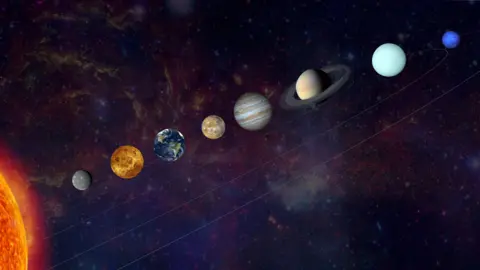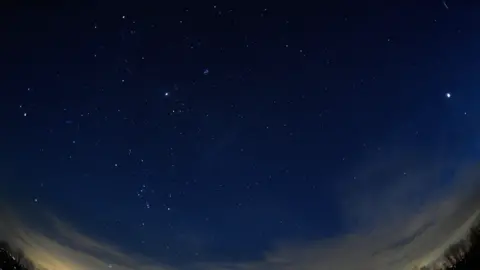BBC Climate & Science
Skywatchers are in for a treat this week as seven planets – Mars, Jupiter, Uranus, Venus, Neptune, Mercury, and Saturn will all be briefly visible in the evening sky.
This phenomenon, known as a ‘planetary parade’ is a rare sight, and it will be the last time seven planets can be seen simultaneously until 2040.
The best chance to see as many planets as possible will be just after sunset on Tuesday, Wednesday and Thursday.
Four of the planets – Mercury, Venus, Jupiter, and Mars – will be visible to the naked eye. Saturn will be harder to see because it will be low in the horizon. You will need a telescope to spot the other two planets – Uranus and Neptune.
 Getty Images
Getty ImagesA good view of the horizon and clear skies will offer the best chance of spotting them all. However, the window to see all seven planets will be very brief.
Dr Edward Bloomer, astronomer at the Royal Observatory Greenwich said: “There’s a rare opportunity to have seven planets in essentially a convenient place for you to look for them.”
As the sun sets, Saturn and Mercury will also be setting, making them particularly difficult to see.
“You really only have a few minutes after sunset to catch them before they drop below the horizon. After that, you’ll still be able to see Venus, Jupiter, and Mars clearly for a much longer time,” Dr Bloomer added.
The planets in our solar system orbit the Sun within roughly the same flat plane as the Earth.
As they orbit at different speeds and distances from the Sun, there are moments when they appear to line up from Earth’s perspective creating a spectacular visual display, although the planets remain separated by vast distances in space.
 Getty Images
Getty ImagesVenus and Jupiter will be the easiest to spot due to their brightness, while Mars will have a distinct reddish hue.
“Uranus is technically visible with the naked eye, but you’d need perfect eyesight and ideal conditions,” Dr Bloomer explains.
To improve your chances of seeing as many planets as possible, Dr Bloomer advises heading to a location with a clear view of the horizon and minimal light pollution.
“If you just pop out of your kitchen into your back garden, you will take time to adjust to the light levels. Give it a bit of time – your eyes take about half an hour to fully adjust,” said Dr Bloomer.
“Avoid looking at your phone, get comfortable, and ensure you have an unobstructed view of the horizon.”
While this is an exciting opportunity, Dr Bloomer encourages people to make a habit of gazing at the night sky.
“See how things change,” he said, adding that observing the heavens is “a chance to witness the ongoing mechanics of the solar system at work.”



